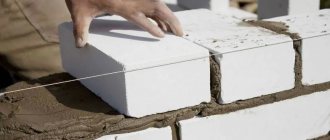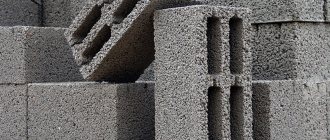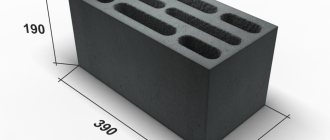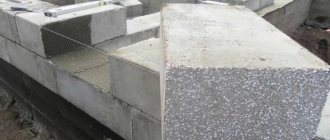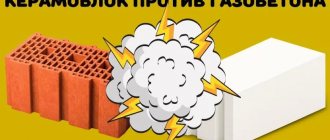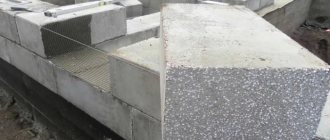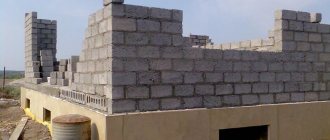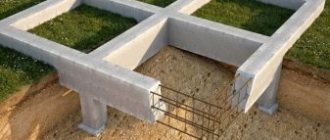Expanded clay blocks: advantages and nuances
Expanded clay blocks are widely used in the construction industry; they are also called expanded clay concrete. Due to the presence of a special filler in concrete - expanded clay, the material is highly durable and lightweight. In addition to the advantages, like any material, expanded clay blocks have their disadvantages.
Different sizes of expanded clay concrete blocks make it possible to expand the scope of application of this building material. Manufacturers produce blocks, the parameters of which depend on the individual order.
The most common ones are:
- 190x390x90 mm;
- 190x390x188 mm.
Compared to brickwork, such a block replaces three to seven bricks. The indicated dimensions are optimal for the construction of residential, civil or industrial premises. Expanded clay concrete blocks have similar technical characteristics, which we will consider below.
First of all, let's say that they hold heat very well.
Energy saving
Thermal conductivity is a significant parameter when choosing expanded clay blocks and calculating the material. The ability of a material to retain heat depends on the density of the block.
| Density, kg/m3 | Thermal conductivity coefficient, W/(mS) |
| 1800 | 0,81 – 0,90 |
| 1600 | 0,66 – 0,78 |
| 1400 | 0,57 – 0,64 |
| 1200 | 0,45 – 0,53 |
| 1000 | 0,32 – 0,42 |
| 800 | 0,25 – 0,32 |
| 600 | 0,21 – 0,27 |
| 500 | 0,18 – 0,24 |
Types and characteristics
Construction with blocks is much faster than with bricks. The cost directly depends on the size of the blocks and their design.
All expanded clay block sizes have clear boundaries with slight variations, and they cannot be exceeded more than indicated:
- length +/- 0.4 cm;
- height +/- 0.4 cm;
- width +/- 0.3 cm;
- plane of edges and edges of straightness - no more than 0.6 cm.
The dimensions and width of expanded clay blocks are important when determining the area of application of the block. Some are best used in the construction of residential buildings, while others are better used for industrial premises.
Today there are two types of blocks:
- Wall ones - most often 20x20x40 cm. They are used to create load-bearing external walls.
- Partition walls – 10x20x40 cm. Designed to form interior partition walls.
Transporting and storing standard-sized blocks is much easier than custom-made ones. The work process does not require special tools and equipment.
The special properties of expanded clay concrete blocks make it possible to use them for the construction of not only one-story, but also multi-story buildings where there is a heavy load - multi-story garages, shopping centers and others.
The strength of the material is no less important.
The production of such building material occurs in accordance with GOST 6133-99. Technical characteristics of expanded clay concrete blocks:
- compressive strength according to standard M35 – M100;
- thermal conductivity is A-7;
- stone weight from 15 to 26 kg;
- density parameters 950-1900 kg/m2;
- frost resistance F35 – F50;
- presence of radioactivity in accordance with certificate No. 71.ТЦ.04.574.П.000203.03.07.
Depending on their purpose, blocks are divided:
- Solid ones are the most expensive type, because a lot of raw materials are used to form such blocks. They are used to create load-bearing structures.
- Hollow - mainly perform soundproofing and heat-insulating functions. Inexpensive because a small amount of materials is spent on their production.
The composition of expanded clay concrete includes the following components:
- cement;
- sand;
- water;
- expanded clay – granules whose size is more than 0.5 cm.
The durability of expanded clay concrete blocks is another reason to turn your attention in their direction
After mixing, the material dries naturally. Therefore, the blocks are solid and monolithic, which gives even more strength.
Colored coatings
Expanded clay concrete blocks are used in the construction of walls both indoors and outdoors. Therefore, colored coatings will give the room an aesthetic appearance. Using this material, you do not need to additionally plaster the walls, which will significantly save your budget.
Facing blocks have a large selection of color palettes, so it is easy to choose your own color for each client. After finishing the blocks with cladding, there is no need to additionally paint or decorate the walls, because they will already have a decent appearance.
With decorative coating
Expanded clay concrete building blocks with cladding are used to cover the building. The structure consists of:
- concrete, located in two layers;
- polystyrene foam, which is located between the concrete balls.
Cladding with expanded clay will cost several times less than other materials. Using blocks with decorative coating, you can insulate old buildings or cladding them. All this allows them to be used to form a unique design on any external surface. The choice of block colors and variety of textures will easily transform any structure.
Expanded clay concrete blocks are environmentally friendly
It is not necessary to use monotony in your work. It is often practiced to use several colors on one wall.
Additional information
- The density of gas silicate blocks is from D400 to D700, that is, from 350 to 900 kg/m3.
- The strength of gas silicate blocks is from 10 to 50 kg/cm2 (B0.75–B3.5 and higher).
- Weight – 5–40 kg/piece.
- Service life – from 50 years.
- Energy saving – 0.15-0.3 W/mS.
- Frost resistance – F25–F75.
- Fire safety - does not burn.
- Vapor permeability – 0.26–0.16 mg/m h Pa.
Now that you know the characteristics of both materials, you can compare them and choose the best one. Let's look at the positive and negative aspects of the products.
Advantages of the material
Before starting any construction, it is important to consider the pros and cons of expanded clay blocks. They have many advantages and positive qualities that are important in the construction of buildings.
Thermal insulation
The material has good thermal insulation. Houses built from expanded clay concrete blocks are warm. The degree of heat retention by expanded clay concrete blocks directly depends on the amount of expanded clay filling.
Solid blocks will provide the best thermal insulation. In addition, the properties depend on the manufacturer. When making blocks, he can save on expanded clay and replace some with other materials. In this case, even solid blocks will not guarantee good heat retention.
Therefore, if the material is made with high quality, and the manufacturers did not spare expanded clay, then the blocks will have high thermal insulation rates. This explains its popularity in the cold countries of Scandinavia.
The specific gravity of a wall made of expanded clay concrete blocks is approximately 2.5 times less than that of brick
Durability
Since the material has good frost resistance, the constructed building will last for decades.
Strength
If you use expanded clay concrete blocks with strength grade M75, then you are allowed to build a three-story building. This material is an ideal combination of strength and heat retention. Strength is expressed in megapascals - MPa. Depending on this indicator, the use of blocks will differ.
Frost resistance
An important indicator for a building material. The designation F together with the number indicates how many freezing and thawing cycles the material is designed for. Expanded clay concrete blocks can withstand repeated repetition of these cycles, which allows them to maintain their properties for a very long time.
Vapor permeability and moisture resistance
The material has low moisture absorption rates. This affects the general condition of the units and their service life. Water that is absorbed by any material during the cold season freezes and expands. As a result, the material becomes cracked and destroyed.
Expanded clay filling provides not only a good climate in the house, but also excellent sound insulation
Environmental friendliness
Expanded clay concrete blocks are highly environmentally friendly due to the use of natural materials - sand, water, cement and expanded clay. No more chemical components are added. There are also no surfactants - surfactants that are used to create gas blocks.
Ease
A wall made of such blocks weighs two and a half times less than one made of brick. Therefore, the foundation may not be as strong.
Labor intensity and cost
You can create structures from blocks with your own hands using step-by-step instructions. Creating masonry from expanded clay concrete is much faster than from brick. One block can replace about seven bricks. Since the process occurs at a faster speed, less effort and finances are spent. After all, the cost of such a number of bricks is equivalent to one block. You will also need less solution than usual.
Noise insulation
Expanded clay filler helps achieve this. It also creates a good indoor microclimate. Sound insulation is especially important for construction in noisy places (near railways, highways, industrial zones).
Another plus is the chemical inertness of expanded clay blocks, as well as the ability to resist fungus
Chemical inertness of expanded clay concrete
Therefore, fungus, mold and pathogenic microorganisms do not appear on the blocks.
The listed advantages of expanded clay concrete blocks speak for themselves. Of course, there are also disadvantages to this material. But the advantages are enough to start using them.
conclusions
The use of expanded clay concrete facing blocks significantly reduces the material consumption of construction, minimizes the number of wet processes, and eliminates the need for additional insulation of external walls and finishing work.
Thanks to a well-thought-out range of products, there is no need to cut blocks in the construction environment. The variety of textures and colors of the blocks allows you to diversify the color scheme of the facades as much as possible. We can safely say that facing and expanded clay concrete facing blocks are one of the best materials for individual low-rise construction.
Disadvantages of the material
In addition to the advantages, expanded clay concrete blocks have their disadvantages:
- The appearance of expanded clay concrete may require further cladding. Although recently this texture has served as a bold basis for interior design.
- When constructing large structures, accurate calculations are required that will take into account the strength of the material.
- Heavy concrete has better physical and mechanical properties than expanded clay concrete due to its high porosity.
- Ventilation of the walls is more difficult than in the brick version.
Despite this, the quality characteristics of expanded clay blocks mean much more than minor disadvantages that can be easily eliminated.
Due to the increased level of porosity, the physical and mechanical characteristics of expanded clay concrete are slightly inferior in comparison with heavy concrete
Flaws
Among the disadvantages, we can mention the fragility of the products, which requires caution during transportation.
PLEASE NOTE - to achieve greater strength and increase load-bearing capacity in masonry, it is recommended to use two types of stones: front and solid on the inside for load-bearing walls.
Facing products can be recommended for cladding existing buildings. In this case, the finishing layer is installed on an additional foundation footing and connected to the existing walls with fastening anchors embedded in the facing masonry.
This method can also be used to insulate wooden buildings made of timber. The material can be used for laying walls of buildings for any purpose - housing, garages, outbuildings, as well as fences and landscape structures.
Manufacturers, in their desire to make life easier for builders, went further and launched the production of decorative expanded clay concrete blocks - sandwiches, that is, already having polystyrene foam insulation and an outer finishing layer.
Such products, having the advantages of front ones, minimize the thickness of external walls and further reduce the load on the foundations. The only disadvantages include the flammability of G3 polystyrene concrete. Decorative products that imitate brickwork are especially popular among developers.
Recommendations
If you have the desire, time and funds, then it is quite possible to make expanded clay concrete blocks yourself. First you need to make or purchase a machine for making expanded clay concrete blocks. If you have it, creating blocks of the required dimensions will not be difficult for you. Such production is beneficial for those who are planning to build a house or any other structure on their own.
In order for construction to be as efficient and effective as possible, you need to know how much building materials you will need. To do this you need to be able to calculate their number.
In order not to use many formulas, you can use a special calculator for expanded clay concrete blocks, into which you need to enter information:
- length, height and width of expanded clay blocks in mm;
- perimeter of all walls (total length) in m;
- height of walls at corners in cm;
- wall thickness;
- thickness of the mortar in the masonry in mm;
- masonry mesh;
- block weight.
After this, you will receive the number of blocks required for this construction. Using such a service, you will save on materials because you will not buy anything extra.
The decision to build a house from expanded clay concrete blocks will be correct if you plan to build a warm and durable house for many years
When building houses, floors are often made with expanded clay. This is true for private houses or those premises that are located on the ground floor. Expanded clay retains heat well and has a high level of thermal insulation.
The use of this material is well suited for the construction of specific buildings. Do you want to know how to build a sauna with your own hands from expanded clay blocks? It is enough to familiarize yourself with the materials on the topic.
Cost of expanded clay blocks
When purchasing, you will see that manufacturers indicate different prices for 1 piece and cubic meter of blocks. To calculate, you need to use the formula: 1 cube / (length * width * height) = number of pieces in a cube. Cunning sellers may indicate a whole number in the cube rather than a fraction. When purchasing more than 50 cubes, you can lose dozens of blocks, which means you overpay for the product.
| Type of expanded clay concrete block | Size, mm | Price, rub/piece | Cubed | Price |
| Expanded clay concrete block, 2-hollow | 390x190x190 | 46 | 71,4 | RUB 3,284/m3 |
| Expanded clay concrete block 4-hollow | 390x190x190 | 48 | 71,4 | RUR 3,427/m3 |
| Solid expanded clay concrete block | 390x240x190 | 73 | 56,5 | 4,124 RUR/m2 |
See here for more detailed prices for expanded clay blocks.
Reviews
Real reviews about expanded clay blocks indicate the high popularity of the material and its high qualities. Also, reviews of expanded clay concrete blocks will help create a complete picture of its use in practice.
- We bought blocks of expanded clay concrete to build a summer house. And we are completely satisfied with it. The cottage turned out to be warm and cozy. Due to the size of the blocks, construction went quite quickly, and we managed to cope on our own.
- I took expanded clay blocks with cladding in order to transform the facade of an old house. The blocks are light and colorful. Thanks to their properties, I was able to not only decorate the wall, but also significantly insulate the house.
Features of masonry
It is recommended to use special solutions for laying such blocks . Since there will be no insulation in the future, it is better to use compounds with thermal insulation characteristics. They can also use reinforcing additives.
It is better if the stone is produced with a tongue-and-groove fastening, then the connection of two adjacent expanded clay blocks is simplified.
Since the facade block is the only material and nothing is used after it, it is important to maintain the exact evenness of the masonry . To do this, be sure to pull the string, plumb line, and after laying each stone, check the evenness with a building level. A laser level will provide the greatest accuracy.
At the end of the laying, it is necessary to check all the stones for cleanliness. It is possible that during the work some of the solution got onto the front side, which will spoil the appearance. To eliminate errors, it is better to immediately remove excess glue.
